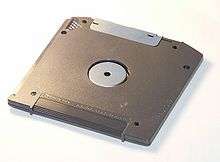Click of death
Click of death is a term that had become common in the late 1990s referring to the clicking sound in disk storage systems that signals a disk drive has failed, often catastrophically.[1]

The clicking sound itself arises from the unexpected movement of the disk's read/write actuator. At startup, and during use, the disk head must move correctly and be able to confirm it is correctly tracking data on the disk. If the head fails to move as expected or upon moving cannot track the disk surface correctly, the disk controller may attempt to recover from the error by returning the head to its home position and then retrying, at times causing an audible "click". In some devices, the process automatically retries, causing a repeated or rhythmic clicking sound, sometimes accompanied by the whirring sound of the drive plate spinning.
Origin of the term
The phrase "click of death" originated to describe a failure mode of the Iomega ZIP drives, appearing in print as early as January 30, 1998.[2] In his podcast of September 18, 2008, Mac journalist Tim Robertson claimed to have coined the phrase in the early 1990s.[3] The phrase was then applied to other drives exhibiting a similar unusual clicking sound usually associated with failure.
Iomega Zip drives
Iomega Zip drives were prone to developing misaligned heads.[2] Dust inside the Zip disks or dirty heads caused by oxide build-up could misalign the heads, but in newer devices it was due to poor quality control and manufacturing defects in the drive itself. Magnetic fields could also cause the drive heads to become misaligned, as the drives were not internally shielded from external magnetic fields. The heads caused the data on the cartridge to become misaligned, rendering it unreadable. The Zip cartridges also wore out, grew defects, or otherwise lost all four 'Z tracks'. If all four redundant 'Z tracks' were lost, the cartridge was unusable, since retail drives are unable to low-level format the disks.
With a malfunctioning drive or cartridge, the drive heads tried to read the Zip disk, but could not find a good Z track or hit a bad spot during a read operation. As part of the drive's retry program, the controller would quickly snap the head arm back into the drive and out again, producing a specific number of 'clicks'. This happens each time a data request fails: the drive parks the heads and then relaunches them. Parking and relaunching continued until the data had been read or a set number of attempts had been reached.
The Zip drive had a very low-cost and revolutionary linear actuator to move the read/write head back and forth on the Zip disk media. This actuator slid back and forth on a single thin steel rod using two sleeve bearings. Under normal drive use, the actuator was under the servo control of the drive. If the drive had its power removed inadvertently by being unplugged or power outage, the read/write heads were pulled off the disk by a power-loss circuit. This was to prevent damage by the heads being left on the media. When the actuator was removed in this manner, it slammed to a stop at the end of its travel. This violent stopping of the actuator could damage the fragile suspension system of the read/write head. To protect from this damage, the drive designers placed a small doughnut-shaped foam washer at the end of the thin steel bearing the actuator slid on. A cost reduction effort within Iomega manufacturing decided that to reduce cost, they would remove this part. Zip drives that followed for a several month period exhibited the click of death. This omission was discovered by the drive's original designers and the washer was put back into the design, and new Zip drives did not experience this click of death.
In rare cases, a Zip cartridge with disk edge damage could rip off the heads in a Zip drive. The damaged disks could go on to damage the heads of any other drive they were used in. A previously good drive would click as if a mis-written cartridge had been inserted. Replacement drives had a warning about damaged ZIP cartridges on a peel-off label and quick visual inspection instructions.
A lifetime warranty on the 100 MB cartridge was misleading as to the actual cartridge life, and future products like the 250 MB offerings carry a 5-year or less warranty from Iomega.
Iomega received thousands of complaints about the click of death. Iomega stated that fewer than 1 in 200 Jaz and Zip drive owners were affected by the click of death.[1] Iomega often stated that the problems were caused by the use of (functionally identical) third-party media. A class action suit (Rinaldi v. Iomega Corp., 41 U.C.C. Rep. Serv. 2d 1143) was filed against them for violation of the Delaware Consumer Fraud Act[4] in September 1998. The case was settled in March 2001 which resulted in Zip drive owners being given a rebate toward the future purchase of an Iomega product.
Hard disk drives
On a hard disk drive, the click of death refers to a similar failure mode; the head actuator may click or knock as the drive repetitively tries to recover from one or more errors. These sounds can be heard as the heads load or unload, or they can be the sounds of the actuator striking a stop, or both.
See also
References
- "The Click of Death Ate My Data". PCWorld. January 15, 1999. Archived from the original on September 6, 2011. Retrieved September 12, 2011.
- Festa, Paul (30 January 1998). ""Click of death" strikes Iomega". CNET. CBS Interactive. Retrieved 28 October 2018.
- MyMac Podcast #201 Archived 2009-08-26 at the Wayback Machine, 00:56:40 – 00:58:30.
- Wittenberg, Jeffrey D. (2012). Products Liability: Recreation and Sports Equipment. ALM. p. 13–54. Retrieved 2011-09-12 – via Google Books.